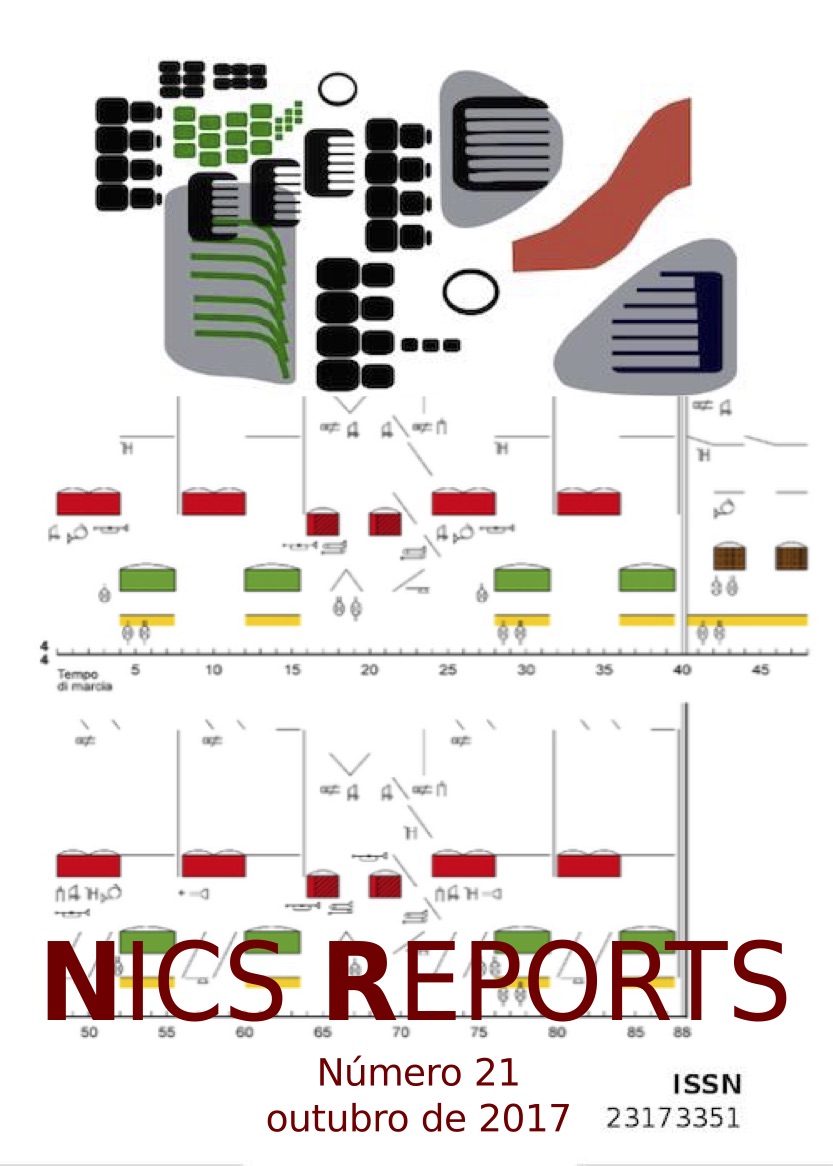Abstract
Ethology is a subfield of Zoology that studies animal behavior, gestures and patterns of expression in order to obtain information about their emotional state. These ideas can be used for the study of emotions evoked by music, in terms of musical listening and/or performance. This work investigates the occurrence of musical meaning generated by the manipulation of sound objects (in terms of expressed or perceived meaning), as well as its following effects in the listeners, such as evoked emotion. This article aims to relate analytical psychology, on symbols and the unconscious mind, with principles of ethology, on animal (including human) communication, in relation to the cognitive, emotional and behavioral processes related to music listening.
References
BRANDT, A. Music and the abstract Mind. The Journal of Music and Meaning, v. 7, 2009.
CLAYTON, M., SAGER, R., WILL, U. In time with the music: the concept of entrainment
and its significance for ethnomusicology. In: EUROPEAN MEETINGS IN
ETHNOMUSICOLOGY (11.), 2005. Proceedings of the European Meetings in
Ethnomusicology. Romanian Society for Ethnomusicology, 2005.
DAMÁSIO, A. O Mistério da Consciência: Do corpo e das emoções ao conhecimento de si.
São Paulo: Companhia das Letras, 1999.
DAMÁSIO, A. Fundamental Feelings. Nature, v. 413, 2001.
DAVID, C. M. O. Objeto Sonoro em Freud. Psicanálise & Barroco - Revista de Teoria
Psicanalítica, v. 7, Juiz de Fora, MG, 2006/2007.
ESCHEN, J. Th. Analytical Music Therapy. Jessica Kingsley Publishers, 2002.
GARCIA-ROZA, L. A. Freud e o inconsciente. 24a. Edição. Rio de Janeiro: Jorge Zahar
Editor, 2009.
GREEN, J. Understanding the Score: Film music communicating to and influencing the
audience. University of Illinois Press. Journal of Aesthetic Education, v. 44, n. 4, pp. 81-94,
HURON, David. Understanding music-related emotion: Lessons from ethology. In:
CAMBOUROPOULOS, E., TSOUGRAS, C., MAVROMATIS, P., & PASTIADIS, K.
Proceedings of the 12th International Conference on Music Perception and Cognition.
Thessaloniki, Greece: 2012c, pp. 473-482.
HURON, D., YIM, G. & CHORDIA, P. The effect of pitch exposure on sadness judgments:
An association between sadness and lower-than-normal pitch. In DEMOREST, S. M.,
MORRISON, S. J., CAMPBELL, P. S. Proceedings of the 11th International Conference on
Music Perception and Cognition. Seattle, Washington: 2010. pp. 63-66.
HURON, D., & DAVIS, M. The effect of scale degree modifications on average interval size.
In: DEMOREST, S. M., MORRISON, S. J., & CAMPBELL, P.S. Proceedings of the 11th
International Conference for Music Perception and Cognition. Seattle, Washington: 2010b.
HURON, D. A comparison of average pitch height and interval size in major- and minor-key
themes: Evidence consistent with affect-related pitch prosody. Empirical Musicology Review,
v. 3, n. 2, pp. 59-63, 2008.
JUNG, C. G. O Homem e seus Símbolos. 6a
Edição. Rio de Janeiro: Editora Nova Fronteira
S.A., 2008.
JUNG, C. G. Os Arquétipos e o Inconsciente Coletivo. 2a
Edição. Petrópolis, RJ: Editora
Vozes Ltda, 2002.
JUSLIN, P., LAUKKA, P. Communication of Emotions in Vocal Expression and Music
Performance: Different Channels, Same Code? Psychological Bulletin, v. 129, n. 5, pp. 770–
, 2003.
NEBENZAHL, B. F. The Narative Power of Sound: Symbolism, emotion & meaning
conveyed through the Interplay of sight and sound in Terrence Malick´s Days of Heaven.
University of California, Los Angeles, 2000.
PANKSEPP, J. The emotional antecedents to the evolution of music and language. Musicœ
Scientiœ. Special Issue, pp. 229-259, 2009/2010.
PANKSEPP, J., BERNATZKY, G. Emotional sounds and the brain: the neuro-affective
foundations of musical appreciation. Behavioral Processes,v. 60, pp. 133-155, 2002.
PATEL, A. Music, Language, and the Brain. Oxford, USA: Oxford University Press, 2008.
REZNIKOFF, I. On Primitive Elements of Musical Meaning. The Journal of Music and
Meaning, v. 3, Fall, Section 2, 2004/2005.
SCHÄFER, T., SEDLMEIER, P., STÄDTLER, C., HURON, D. (2013). The Psychological
functions of music listening. Frontiers in Psychology.
SCHERER, K., COUTINHO, E.. How music creates emotion: a multifactorial process
approach. In: The emotional power of music. Oxford University Press, 2013.
SCHLAUG, G. et al. Effects of voice on emotional arousal. Frontiers in Psychology, v. 4, n.
, 2013.
SOLANKI, M. S., ZAFAR, M., RASTOGI, R. Music as a Therapy: Role in psychiatry. Asian
Journal of Psychiatry, pp.193-199, 2013.
TREHUB, S., HANNON, E., SCHACHNER, A. Perspectives on music and affect in the early
years. 2010.

This work is licensed under a Creative Commons Attribution 4.0 International License.
Copyright (c) 2017 NICS Reports

